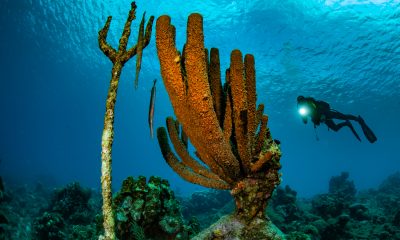Photo / Video News & Reviews
Shooting in Less than Perfect Visibility in the Maldives
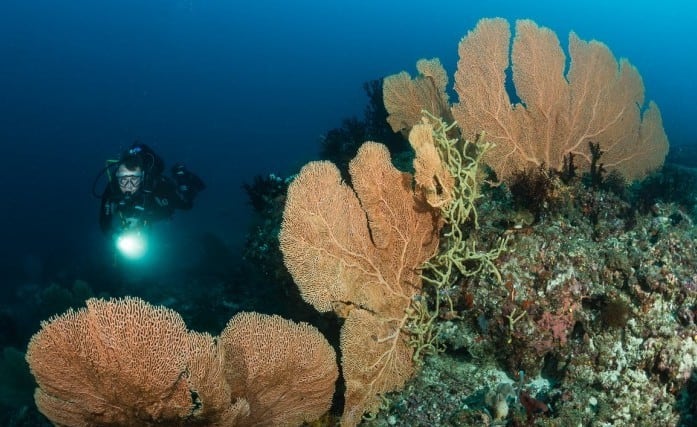
I’ve recently returned from the Maldives on the rather swish and fabulous MV Orion, one of the stars of the Constellation Fleet. Your approach to taking pictures in the Maldives has to be altered as the seasons and locations alter.
At times of the year the visibility can rival the Red Sea; however, a lot of the time it is compromised by comparison. One of the reasons that the waters in this area are frequented by large pelagic beasts like Manta and Whalesharks is because of the tiny plankton providing the major food for these ocean giants. This tiny plankton, in the main, is what hampers the visibility. If you’ve kept track of my recent Facebook posts of those Manta and Whalesharks though, you could be forgiven for thinking that the visibility was crystal clear. And certain adaptations are what is needed to shoot in this less than perfect visibility to make your photos look like the viz is clearer than it is.
I find that the age old adage of underwater photographers to “get close” is never more apt than when in these slightly murkier conditions.

This is exactly the sort of example that shows the Maldives looking its most colourful. It’s a deception really due to the colourful balled up anemone in the foreground, it’s been shot using a fisheye lens, and I’m shooting through only inches of water – the less than perfect viz is disguised.
A Fish Eye View
So I choose to shoot with a fisheye lens and really get close when shooting reef scenes, placing the main object of interest in the forefront of the frame. This tends to lead the eye into the picture which is a great compositional stand by, and it also has the benefit of shooting through much less water for this close object, so even if the background isn’t crystal clear and distinct, the foreground will be.
One of the more frustrating creatures to shoot well in the Maldives is the relatively frequent visiting reef sharks. Usually White Tips swirling in the currents at the edges of channels, but occasionally you may get visited by Grey Reefs too.
I have always had difficulty shooting these with my standard weapon of choice, the fisheye lens.

OK, here is a subject that demands a dramatic angle. I was shooting with a longer than normal focal length, so unable to let the drama by ramping it up with a “fisheye in it’s face” sort of a composition, which just wasn’t possible. Fearsome though they may seem, this shark like most was quite shy. So I opted for a short telephoto lens to make them big in the frame. This meant that to turbo charge the dynamics a bit I simply tilted the camera. Well actually I didn’t, I lie – what I did was take a pretty straight shot and after converting it to black and white I cropped it in Lightroom with a bit of a tilt. Although to be perfectly honest if you can remember to frame like this in the first place you won’t waste any valuable pixels, and keep the quality high.
And so on occasion I have resorted to using longer focal lengths, from standard wide angle lenses all the way through to short telephoto or macro lenses. This is of course a compromise, and you still end up shooting through plankton-filled water, but at least you can get something. In fact if you have a compact camera with a range of focal lengths you may well end up getting closer and often better shots than those of us sporting super wide fish eye lenses.
Go Big, or Go Home
Luckily the largest of the Maldives marine life, the Manta’s and Whale Sharks, are usually quite easy to get close to, so it’s back to the fisheye and wide-angle lenses for these.
You still have to be careful though as one of the other unwanted side effects of shooting in plankton-rich water is that your strobe positioning needs to be attended to with more care, as the plankton will cause back scatter really easily. So I always make sure that my strobes are positioned well behind the dome lens front, and also pointed slightly out.

My strobe positioning for these two (3) manta circling overhead was more a case of luck than judgement, as they happened to be at just the right distance from me to get proper strobe coverage with minimal backscatter. You can see it’s not as clear by the manta in the distance (bottom left).
For the picture below of the Whale Shark I’ve used the exact same technique that I used in Mexico to shoot the Whale Sharks there, with Shutter Priority.
The Whale Shark was only encountered from a snorkelling viewpoint and so to make myself more streamlined and hydrodynamic I removed the strobes from my rig. Just like in Mexico I only managed a few shots, before I ran out of steam, as the Whale Shark “sped” by me in a rather languid fashion!

I was lucky that this Whale Shark turned towards me, and as it’s relatively slow moving shutter priority has frozen its languid movements.
So in summary the trick to getting clearer shots is very simple – you need to get rid of as much water between you and the subject as possible, so the order of the day is a wide angle lens of some description, and generally with the exception of shooting shy sharks the wider the better.
[hr style=”single”]
 Duxy is the in house photo-pro for UK-based dive tour operator Scuba Travel. To find out about availability on Scuba Travel’s underwater photography workshops hosted by Duxy click here.
Duxy is the in house photo-pro for UK-based dive tour operator Scuba Travel. To find out about availability on Scuba Travel’s underwater photography workshops hosted by Duxy click here.
Blogs
Diver Discovering Whale Skeletons Beneath Ice Judged World’s Best Underwater Photograph
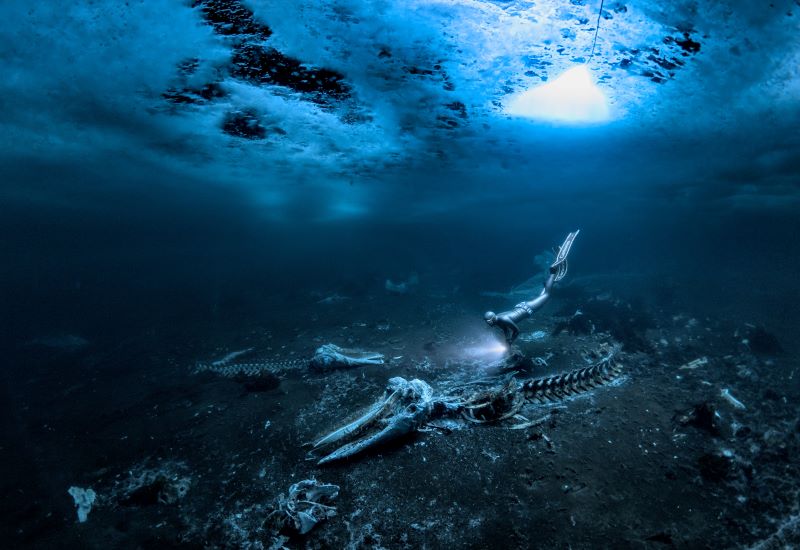
An emotive photograph showing a freediver examining the aftermath of whaling sees
Alex Dawson from Sweden named Underwater Photographer of the Year 2024. Dawson’s
photograph ‘Whale Bones’ triumphed over 6500 underwater pictures entered by underwater
photographers from around the world.
“Whale Bones was photographed in the toughest conditions,” explains chair of judging
panel Alex Mustard, “as a breath-hold diver descends below the Greenland ice sheet to bear
witness to the carcasses. The composition invites us to consider our impact on the great
creatures of this planet. Since the rise of humans, wild animals have declined by 85%. Today,
just 4% of mammals are wildlife, the remaining 96% are humans and our livestock. Our way
needs to change to find a balance with nature.”
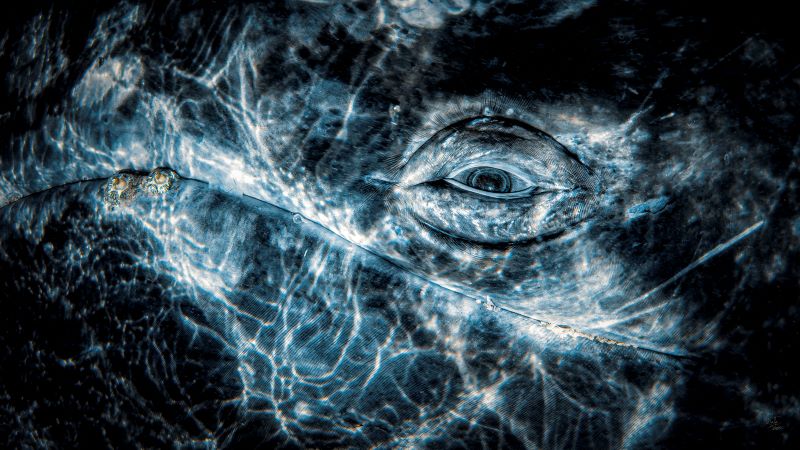
Photo: Rafael
Fernandez Caballero
Whales dominated the winning pictures this year with Spanish photographer Rafael
Fernandez Caballero winning two categories with his revealing photos of these ocean giants:
a close up of a grey whale’s eye and an action shot of a Bryde’s whale engulfing an entire bait
ball, both taken in Magdalena Bay, Baja California, Mexico. Fernandez Caballero took ‘Grey
Whale Connection’ while drifting in a small boat, holding his camera over the side in the water
to photograph the curious whale. ‘The End Of A Baitball’ required Fernandez Caballero to dive
down and be in exactly the right place at the moment the whale lunged. “The photo shows
the high speed attack,” he said, “with the whale engulfing hundreds of kilograms of sardines
in one bite — simply unforgettable to see predation on such a scale.”
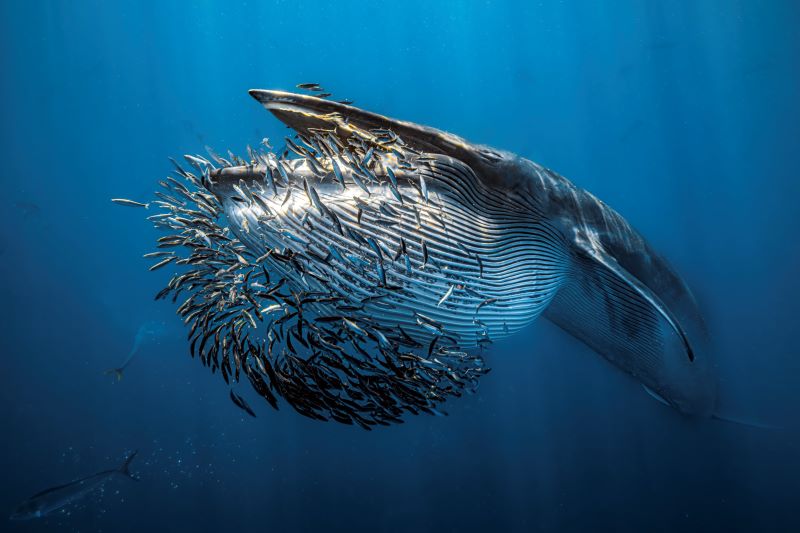
Photo: Rafael
Fernandez Caballero
Lisa Stengel from the United States was named Up & Coming Underwater Photographer of the Year 2024 for her image of a mahi-mahi catching a sardine, in Mexico. Stengel used both a very fast shutter speed and her hearing to catch the moment. “If you listen there’s an enormous amount of sound in the ocean,” she explained. “The action was too fast to see, so I honed in on the sound of the attacks with my camera to capture this special moment.”
“It is such an exciting time in underwater photography because photographers are capturing such amazing new images, by visiting new locations and using the latest cameras,”
commented judge Alex Mustard. “Until this year I’d hardly ever see a photo of a mahi mahi,
now Lisa has photographed one hunting, action that plays out in the blink of an eye.”
The Underwater Photographer of the Year contest is based in the UK, and Jenny Stock,
was named as British Underwater Photographer of the Year 2024 for her image “Star
Attraction”, which finds beauty in species of British wildlife that are often overlooked.
Exploring the west coast of Scotland, Stock explained “in the dark green depths my torch
picked out the vivid colours of a living carpet of thousands of brittle stars, each with a
different pattern. I was happily snapping away, when I spotted this purple sea urchin and I
got really excited.”
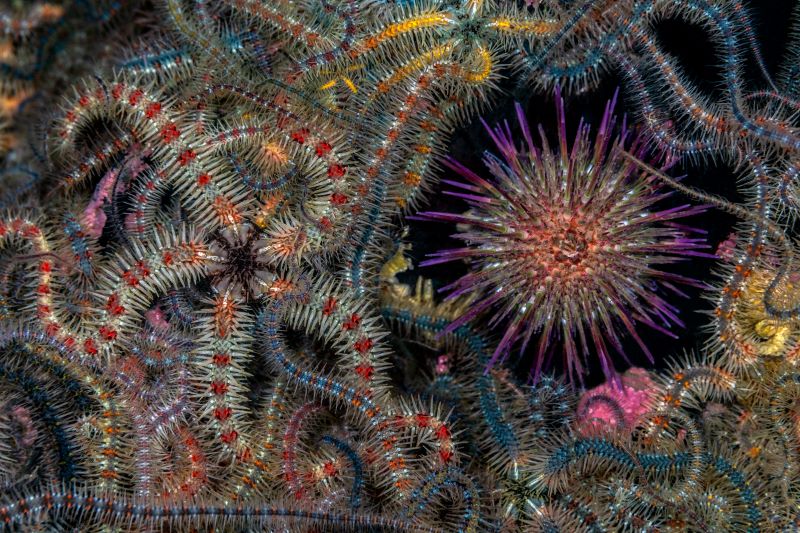
Photo: Jenny Stock
In the same contest, Portuguese photographer, Nuno Sá, was named ‘Save Our Seas
Foundation’ Marine Conservation Photographer of the Year 2024, with his photo ‘Saving
Goliath’, taken in Portugal. Sá’s photo shows beachgoers trying to save a stranded sperm
whale. The picture gives us hope that people do care and want to help the oceans, but also
warns us that bigger changes are needed. “The whale had been struck by a ship and its fate
was sealed,” explains Sá. “An estimated 20,000 whales are killed every year, and many more
injured, after being struck by ships-and few people even realise that it happens.”
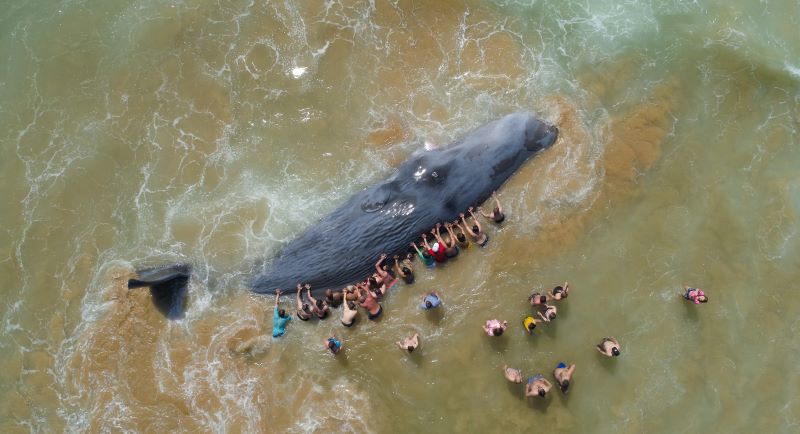
Photo: Nuno Sá
More winning images can be found at www.underwaterphotographeroftheyear.com.
About Underwater Photographer of the Year
Underwater Photographer of the Year is an annual competition, based in the UK, that celebrates photography beneath the surface of the ocean, lakes, rivers and even swimming pools, and attracts entries from all around the world. The contest has 13 categories, testing photographers with themes such as Macro, Wide Angle, Behaviour and Wreck photography, as well as four categories for photos taken specifically in British waters. The winners were announced in an award ceremony in Mayfair, London, hosted by The Crown Estate. This year’s UPY judges were experienced underwater photographers Peter Rowlands, Tobias Friedrich and Dr Alexander Mustard MBE.
Header image: Underwater Photographer of the Year 2024 winner Alex Dawson
News
World’s Best Underwater Photographers Unveil Breathtaking Images at World Shootout 2023
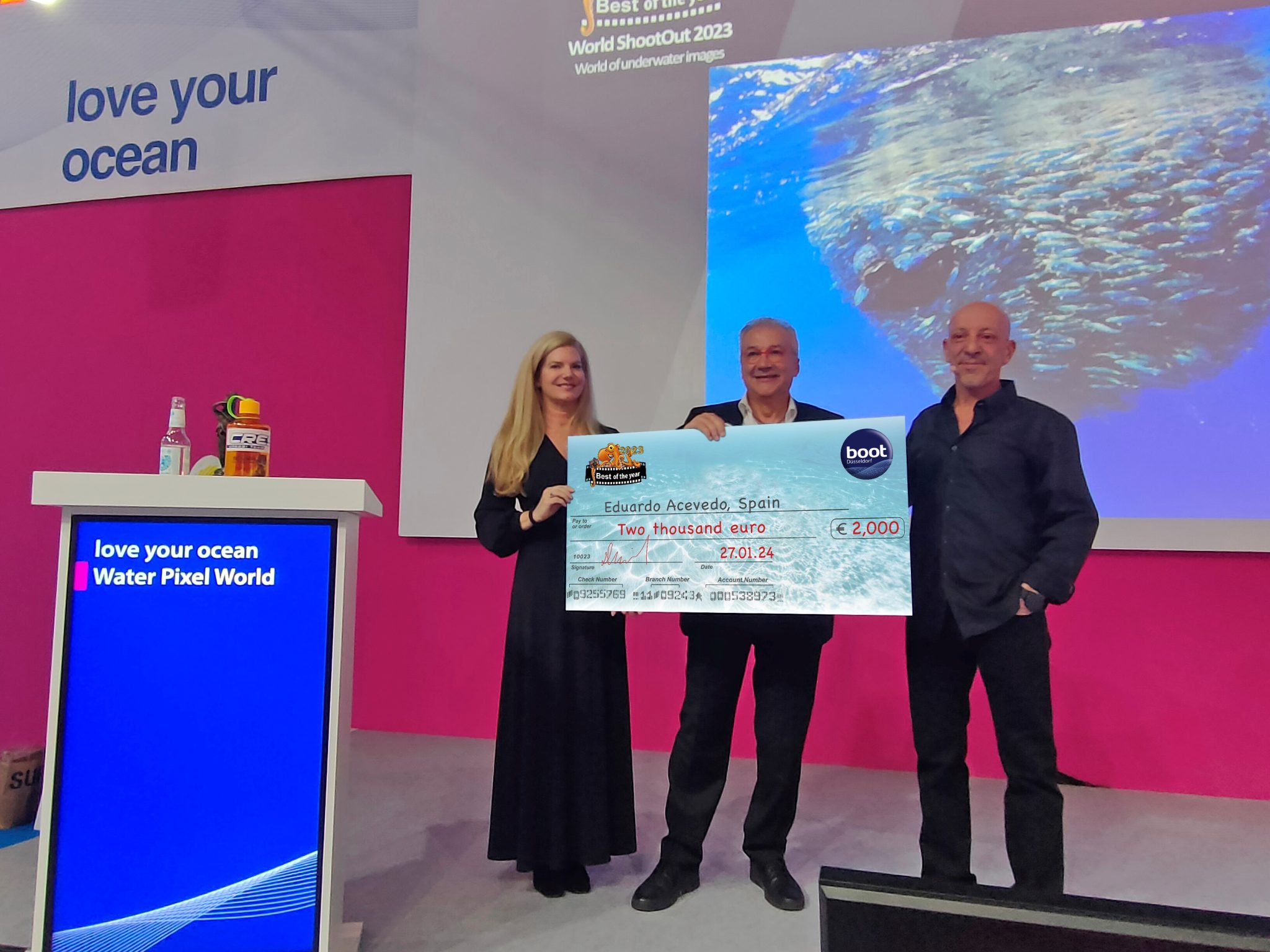
The winners of the prestigious World Shootout 2023 underwater photography competition were announced at this year’s BOOT Show, captivating audiences at the world’s largest diving and water sports exhibition in Dusseldorf, Germany. Hundreds of photographers from 54 countries competed across nine categories, pushing the boundaries of creativity and technical skill.
Grand Prize Winners
- Picture of the Year: Spanish photographer Eduardo Acevedo “secured” the top Honor with the prestigious prize the “boot Dusseldorf Director’s Prize, earning an Andromeda statuette and a €2,000 cash prize.
- Best 5 Images Portfolio: Luc Rooman from Belgium triumphed in this category, winning a dream 4-week diving trip for two to Papua New Guinea, valued at $18,900.
- Amateur Photographer: Alexandra Ceurvorst from the USA impressed the judges with her talent, taking home the 1,000 € cash prize award.
Celebrating Diversity and Innovation
This year’s competition saw 11,680 entries from 964 photographers, showcasing a remarkable spectrum of skills and perspectives. From the intricate wonders of Macro photography to the beauty of “Black Water”, the “Underwater Fashion” category added a touch of artistry and innovation, while the ever-important ” Environmental & Conservation” category served as a powerful reminder of the need to protect these fragile ecosystems.
Looking Ahead: AI and Ocean Conservation
World Shootout founder and producer David Pilosof unveiled an exciting addition for the 2024 competition: this year the Environmental category will be focusing on the impact of plastic on our oceans and future.
This category will embrace the potential of AI or other editing software as a tool to amplify the conservation message.
Entrants will submit campaigns of three original underwater photographs dealing with plastic pollution, along with their final AI assistance processing. This innovative approach encourages artistic expression while raising awareness about a critical environmental issue.
Explore the Stunning Collection
Discover the complete album of competition entries by clicking here.
For Low-resolution photos of finalist entries in eight categories, click here.
-

 News3 months ago
News3 months agoHone your underwater photography skills with Alphamarine Photography at Red Sea Diving Safari in March
-

 News2 months ago
News2 months agoCapturing Critters in Lembeh Underwater Photography Workshop 2024: Event Roundup
-

 Marine Life & Conservation Blogs2 months ago
Marine Life & Conservation Blogs2 months agoCreature Feature: Swell Sharks
-

 Blogs1 month ago
Blogs1 month agoMurex Resorts: Passport to Paradise!
-

 Gear News3 months ago
Gear News3 months agoBare X-Mission Drysuit: Ideal for Both Technical and Recreational Divers
-

 Blogs2 months ago
Blogs2 months agoDiver Discovering Whale Skeletons Beneath Ice Judged World’s Best Underwater Photograph
-

 Gear Reviews2 months ago
Gear Reviews2 months agoGear Review: Oceanic+ Dive Housing for iPhone
-
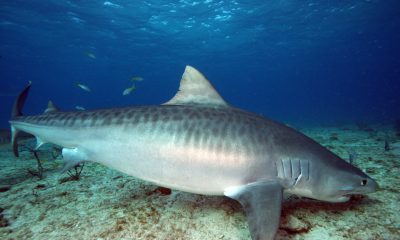
 Blogs3 months ago
Blogs3 months agoThe Thrilling Encounter with Tiger Sharks at Beqa Lagoon’s ‘The Colosseum’ with Coral Coast Divers











